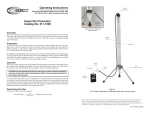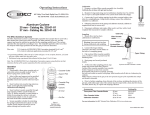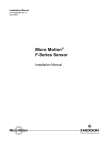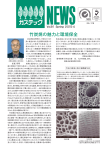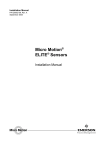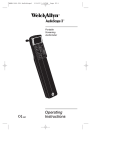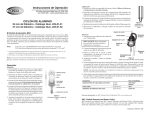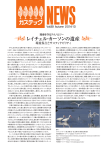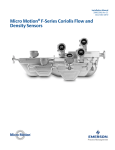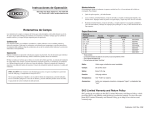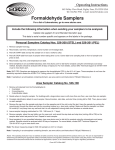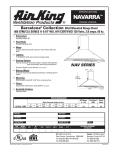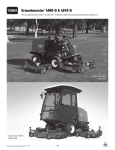Download Ultra II Passive Samplers 590-259 Operating Instructions 40061
Transcript
Operating Instructions 863 Valley View Road, Eighty Four, PA 15330 USA Tel: 724-941-9701 Fax: 724-941-1369 e-mail: [email protected] Ultra II Passive Samplers for Thermal Desorption Introduction SKC Ultra II Passive (diffusive) Samplers provide reliable sampling and highly sensitive detection of ppt and low ppb-level volatile organic compounds (VOCs) through thermal desorption and GC analysis. Ultra II Samplers are packaged as empty sampler housings that the user fills with cleaned/purged sorbent provided in glass vials with PTFE-lined caps. This method of packaging maintains low sorbent background and allows for reuse of the sorbent with care in handling. Collar Clip Collar Clip Diffusion Barrier Vial Adapter Cover Plug Back View of Housing Front View of Housing Vial containing purged sorbent (sold separately) Specifications for Ultra II Dimensions: 1.4 in (3.5 cm) dia. x 2.5 in (6.3 cm) x 0.6 in (1.5 cm) Sorbents: Tenax® TA, Chromosorb® 106, Anasorb® GCB1, or Carbopack X Sorbent is sold separately and supplied in glass vials with PTFE-lined caps. Select the sorbent appropriate for the target compound. Analysis: Thermal desorption using a 0.25-in OD (0.194-in ID) x 3.5-in L thermal desorption tube (Perkin Elmer) and gas chromatography (GC) Shelf-life: Sorbent must be used or repurged 30 days from date of manufacture. Store at < 39.2 F (4 C). Sampling Rates: Go to www.skcinc.com and click on "Sampling Guides." Select "Passive (Diffusive) Sampling Guide." www.skcinc.com Preparation and Sampling Open resealable pouch and remove sampler. Write start time and sample ID number on pouch label. 3A t ben Sor In a clean, organic solvent-free environment, remove plug from vial adapter on back of sampler housing (side without holes). Remove cap from sorbent vial. Hold housing vial adapter down over the open end of the vial. Screw open end of vial into the adapter (see inset 3A). Rotate assembly until sorbent is draining from vial to sampler. Tap vial lightly before removing from adapter. Replace plug on adapter. Sorbent Vial Remove cover from face of sampler housing (side with holes) immediately before sampling. Store cover for reuse. Clip sampler in the area to be sampled. Ensure diffusion holes are not covered. After desired sampling period, unclip sampler and seal with cover. Write stop time on pouch label. 2 Vial Adapter In a clean, organic solvent-free environment, carefully remove plug from vial adapter on back of sampler housing. Screw open end of sorbent vial into adapter (see inset 7A). Rotate assembly until sorbent is draining from sampler to vial. Tap sampler lightly. Ensure all sorbent is recovered in the vial. Screw cap onto vial. 7A Vial Adapter t ben Sor Sorbent Vial Mark sample vial as appropriate and insert into the pouch. Carefully package sample vial and a blank sorbent vial. Send to a laboratory for analysis. Factors for Determining Application and Storage Prior to purchasing Ultra II Samplers, evaluate specific compounds of interest and expected levels. A factor that should be considered is the sorbent. Polymetric sorbents such as Tenax TA can increase in background during storage. Refrigerated storage can reduce, but not eliminate, off-gassing. Storage Before Sampling: Up to 30 days at < 39.2 F (4 C) in a clean, organic solvent-free environment After Sampling: 21 days at < 39.2 F (4 C) in a clean, organic solvent-free environment Analysis 1. Remove cap from vial, pour sorbent from vial into a 0.25-inch OD (0.194-inch ID) x 3.5-inch L thermal desorption tube, and thermally desorb the sample. The Transfer Funnel accessory can facilitate the pouring process (see Ordering). 2. Analyze samples using a gas chromatograph (GC) with the detector specified in the method for the target compound. The thermal desorption process automatically purges the sorbent so that it is ready for reuse. If desired, employ additional in-house purging procedures. Validation‡ Ultra I Passive Samplers were evaluated by the U.S. Military1, 2, OSHA Technical Center (Salt Lake)3, Swedish researchers4, and SKC R&D Laboratories5, 6. Samplers with specific sorbents were found to be suitable for 8-hour workshift sampling, 24-hour indoor air studies targeting medium-to-high boiling point compounds, and for 24-hour or 7-day sampling of benzene and 1,3-butadiene†. 3 Ultra Passive Samplers use the same sorbents and analysis as specified in the active method EPA TO-17. Ultra samplers provide comparable low limits of detection in the low ppb to ppt concentration range for some chemicals while offering the benefits of economy and convenience.7 † Uptake rates for 1,3-butadiene were found to decline over a one-week period. ‡ Ultra I Samplers were used in these studies. However, Ultra II Samplers utilize the same housing and sorbents. The difference is sorbent storage. Ultra II sorbent is stored in glass vials, instead of the housing, before and after sampling to ensure low sorbent background. References 1. Hendricks, W.D., et. al., Feasibility of Diffusive Sampling to Monitor U.S. Military Personnel for Exposure to Toxic Chemical Substances, OSHA, SLTC, Salt Lake City, UT, 2002 2. Hendricks, W., The Marines Project: A Laboratory Study of Diffusive Sampling/Thermal Desorption/Mass Spectrometry Techniques for Monitoring Personal Exposure to Toxic Industrial Chemicals, Industrial Hygiene Division, OSHA, SLTC, Salt Lake City, UT, Apr. 2002 3. Hendricks, W., Performance of SKC Ultra Passive Samplers Containing Carboxen 1016, Carbotrap Z, or Chromosorb 106 When Challenged With a Mixture Containing Twenty of OSHA SLTC’s Top Solvent Analytes, Methods Development Team, Industrial Hygiene Chemistry Division, OSHA, SLTC, Salt Lake City, UT, Feb. 2003, www. osha.gov (search on “Ultra”) 4. Strandberg, B., et. al., “Evaluation of Two Types of Diffusive Samplers and Adsorbents for Measuring 1,3-butadiene and Benzene in Air,” Atm. Environ., Vol. 39, July 2005, pp. 4104-4110 5. Coyne, L., et. al., Using Diffusive Samplers for Monitoring for Ppb Levels of Volatile Organic Compounds in Indoor Air, presented at AirMon 02, Lillehammer, Norway, Feb. 2002 6. Coyne, L., et. al., Using Diffusive Samplers for Monitoring for Ppb Levels of Volatile Organic Compounds in Air, presented at AIHce 2002, San Diego, CA, June 2002 7. SKC Update to EPA Method TO-17 available at www.skcinc.com Ordering Description Catalog No. Sorbent in Vial with PTFE-lined Cap Select the sorbent appropriate for the target compound. Catalog No. Ultra II Sampler, empty housing only, packaged in reusable pouch, requires sorbent in vial listed below Tenax TA Sorbent, 265 mg Chromosorb 106 Sorbent, 285 mg Anasorb GCB1 Sorbent#, 370 mg Carbopack X Sorbent, 500 mg 590-259 590-260* 590-261* ∞ 590-262* 590-265* * Use within 30 days or repurge to ensure low background; storage at < 39.2 F (4 C) recommended. # Comparable to Carbopack B ∞See Reference 3 for additional information on Chromosorb 106 sampling rates. Analysis Accessories Transfer Funnel, aluminum, facilitates transfer of sorbent from vial to 0.25-inch OD thermal desorption tubes Thermal Desorption Tube, Perkin Elmer, includes screens and end caps Catalog No. 590-264 P226530 SKC Limited Warranty and Return Policy SKC products are subject to the SKC Limited Warranty and Return Policy, which provides SKC’s sole liability and the buyer’s exclusive remedy. To view the complete SKC Limited Warranty and Return Policy, go to http://www.skcinc.com/ warranty.asp. Form # 40061 Rev 1005 4






